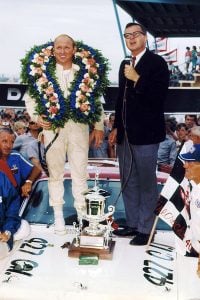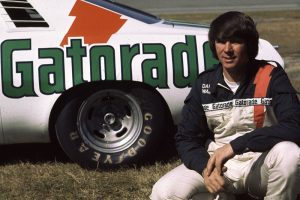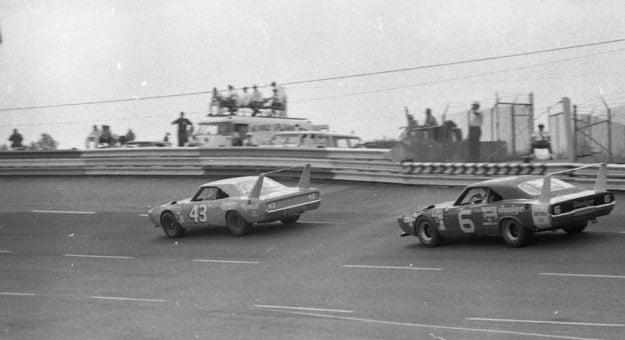The 1970s were a magical period in NASCAR history that featured “The Magnificent Seven,” a small group of elite competitors who enjoyed victory no matter where they raced.
Here’s a look at the seven drivers who defined NASCAR racing during 1970s and positioned the sport for its future transition into mainstream sports.
Bobby Allison began his NASCAR Cup Series career in 1961 and by 1970 had collected 16 victories.
Allison, who won races for four different team owners — including himself — during the period, enjoyed his breakout season in 1970, winning 10 races and finishing fourth in the standings while driving his own Ford.
Allison matched those 10 victories in 1972, driving for team owner Richard Howard and team manager Junior Johnson. He finished second to Richard Petty in the standings.
He won the Southern 500 three times, the Daytona 500 in 1978 and the Winston 500 at Talladega (Ala.) Superspeedway in 1979.
Allison was also involved in the infamous brawl with Cale Yarborough and Donnie Allison during the 1979 Daytona 500, which helped to increase the NASCAR fan base as it occurred during the first live telecast of the event on CBS.
“I was able to collect an incredible amount of wins with several teams as well as my own cars during that era,” Allison said. “I believe among them, if I had been able to stay with Richard Howard and Junior Johnson longer than the 1972 season, we would have been able to win several championships together. We just didn’t get along well enough to do that.”

Buddy Baker knew only one way to race; flat out and in front until he ended up in victory lane or the garage area.
His career began under the tutelage of his father, two-time NASCAR champion Buck Baker, in 1959. He won his first race at Charlotte Motor Speedway on Oct. 15, 1967, driving a Dodge owned by NASCAR legend Ray Fox.
Baker returned to Charlotte to win the Coca-Cola 600 on May 26, 1968, in a Fox Dodge, establishing himself as a two-time superspeedway winner.
He won the 1970 Southern 500 at Darlington in a Dodge owned by former driver Cotton Owens.
He also enjoyed wins in the 1971 Rebel 400 at Darlington, the 1972 and ’73 Coca-Cola 600 at Charlotte, in addition to wins at Talladega, Atlanta Motor Speedway and Michigan Int’l Speedway.
Baker’s biggest victory came just outside the 1970s, when he won the 1980 Daytona 500 while driving for Harry Ranier.
“Baker was one of our drivers in 1983 and ’84,” said Len Wood, co-owner of Wood Brothers Racing. “He was a fierce competitor behind the wheel. I guess you could also call him a gentle giant. He liked to have fun and he liked to tell stories. He was a hard charger. He gave it everything he had.
“He was really good on superspeedways. His last win came with us at Daytona in the Firecracker 400 in July of 1983. We won that one on fuel mileage. He was an excellent superspeedway driver.”
Bobby Isaac entered the 1970 NASCAR season after earning a record 19 poles in 1969. It’s a record that still stands. His 17 victories in ’69 were the best of his career, even though he finished sixth in the standings.
Isaac began the 1970s in his fourth season of driving for Nord Krauskopf. His reputation as a hard-charging scrapper on the track was equally matched by his fiery personality. His lone championship was accomplished under the direction of crew chief Harry Hyde in 1970 after the team earned 11 victories that season.
Isaac collected five more wins in Krauskopf’s Dodges in 1971 and ’72 and entered races for various team owners in the Cup Series through 1976. Sixteen of his 37-career wins came during the 1970s.
Buddy Parrott was a crew member for Isaac.
“The only driver that I can think of that had a relationship with Bobby was David Pearson,” Parrott said. “His background was that he didn’t have a lot growing up. He worked hard for his money.
“When he got on the race track, there wasn’t but one place he wanted to run and that was up front. He was talented, as far as how to use the car. We didn’t have the big brakes back then like we do now. That’s why Harry Hyde liked him so much because he didn’t tear up race cars. He took care of his equipment. He was a thinker in the race car. He would say to himself, ‘I have to make this car finish to make money.’”
David Pearson was considered an elder statesman of NASCAR racing after collecting his third Cup Series title in 1969.
Nicknamed the “Silver Fox” because of his graying hair, Pearson joined Wood Brothers Racing on April 16, 1972, and won his first race with the team at Darlington.
That began a dominance that produced 43 of Pearson’s 105 victories through April 1979. In 1973, Pearson entered 18 Cup Series races and won 11. He won the 1976 Daytona 500 and won 10 times at Darlington.
Pearson and rival Richard Petty finished first and second 63 times with Pearson winning 33 and Petty 30. The two drivers knew everything there was to know about the other’s driving style.
“David knew what I was going to do before I did it and I knew what he was going to do before he did it,” Petty said. “There was nothing else to learn from each other. The only time when I didn’t know what he was going to do was when we raced each other in the Firecracker 400 (1974) and he let off on me and that kind of teed me off. If I hadn’t been on my toes, I would have knocked the fire out of him.”
Richard Petty won five of his seven Cup Series championships, five of his seven Daytona 500s and 86 of his 200 victories between 1970 and ’79.
“The competition is what made the 1970s so good, in my opinion,” Petty said. “I raced against the very best back in those days that ever came through NASCAR. That made me better and made them better. And that made for a better show for the fans.”

Darrell Waltrip came onto the NASCAR Cup Series scene in 1972, driving his own Mercury with “Suitcase” Jake Elder as his crew chief. Two victories in his own Chevrolets set the stage for Waltrip to join DiGard Racing in 1976.
Waltrip collected 10 superspeedway wins and 10 short-track victories during the 1970s with team owners Jim and Bill Gardner among his 84-career victories. Five additional wins came with DiGard in 1980. Waltrip moved on to drive for Junior Johnson in 1981.
“I think the timing was right when I came along in the 1970s,” Waltrip said. “I guess I ruffled some feathers when I came against Bobby and Cale (Yarborough) and Richard, but I knew I could beat them. I knew I had what it took to do it. I was different and had a different approach. I got to where I could win against them and they didn’t like it all that much but they eventually accepted me.”
Cale Yarborough knew from the day he tried to sneak into Darlington (S.C.) Raceway in 1953 that we would someday become a NASCAR driver. That day came in the 1957 Southern 500 when he finished 42nd in the 50-car field.
Yarborough started the 1970s with three superspeedway wins with Wood Brothers Racing but left NASCAR in 1971 and drove Indy cars for team owner Gene White during 1971 and ’72 when Ford Motor Co.exited NASCAR.
Yarborough joined team owner Junior Johnson in 1973 and remained through 1980, winning three championships under the direction of crew chiefs Herb Nab and Jeff Hammond.
“Having known Cale like I did, I think it’s a combination of reasons why he was so good,” Hammond said. “One, it was determination. Two, people didn’t realize that Cale did not work on race cars during the week between races. He worked on the farm. He was tough as nails. Living and working in South Carolina and staying active all the time helped Cale a lot.
“Cale’s background as far as playing semi-pro football, a lot of other things contributed to his ability to get up on that wheel and wrestle the car,” Hammond continued. “They didn’t have power steering in their cars in that era. All these things factored in because he was out there riding on tractors all day long and that made him used to being able to go out and get the job done.
“The thing was that drive and determination was strictly coming from the heart.”
